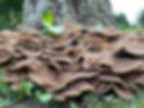Giant polypore - Meripilus giganteus
- The Foraging Course Company
- May 13
- 2 min read

Edible mushroom - novice Season - summer to autumn Common names Giant polypore, blackening polypore, black staining polypore
Scientific name meaning: Meripilus comes from the Greek Meros, meaning a part, and the Latin Pil/Pile meaning a cap or covering. This essentially means the cap is made of many parts. Giganteus is from the Greek Gigantos, meaning a giant, in reference to the size of this fungus's fruit body
Overall structure and growth  Giant polypore is an aggressive parasite that will feed saprobically once the host tree has died. There are usually several large fruits bodies appearing at the same time. The fruit bodies resemble the petticoats on a can-can skirt and have no discernible stem. |
Cap  Cap size can reach between 50 and 80cm, sometimes larger. Many caps are piled one on top of the other and fused at the base of the fruit body. This gives a petticoat like appearance. Cap markings are bands of different shades of brown, and each is thick and fleshy. It bruises and ages black. |
Pores and spores  The pore surface is white and the pores often too small to see with the naked eye. It turns brown then black when bruised. The spore colour is white. |
Flesh, smell and taste  The flesh is white and fibrous, resembling cooked chicken breast when torn apart. It bruises brown and turns black when damaged. The taste and smell is mild and mushroomy. |
Possible lookalikes  Could be confused with hen of the woods (Grifola frondosa), pictured, but this prefers oak, is smaller, has much thinner greyish caps, and does not change colour upon bruising. It is also edible. Some confusion could occur with older specimens of the edible chicken of the woods (Laetiporus sulphureus). This does not change colour if bruised and younger fruit bodies are yellow/orange. |
Use as a food Giant polypore has a rich poultry-like flavour and texture. It can be included into dishes or used as a feature dish. Only young, fresh specimens should be used for eating. Older specimens are tough and acidic. See hazards regarding other consumption warnings Hazards This fungus causes gastric upset in some people. A tolerance test should be carried out when consuming for the first time. Because giant polypore grows close to the ground, care should be taken not to harvest in areas where dogs may foul or pesticides have been used
Use in herbal medicine and medicine Some cytotoxic activity on mouse cancer cells has been seen under lab conditions If you are suffering from any ailment or need medical advice, please see your General Practitioner Other uses None known Importance to other species None known
Always stay safe when foraging. You need to be 100% sure of your identification, 100% sure that your foraged item is edible, and 100% sure that you are not allergic to it (it is good practice to always try a small amount of any new food you are consuming). If in doubt, leave it out!






